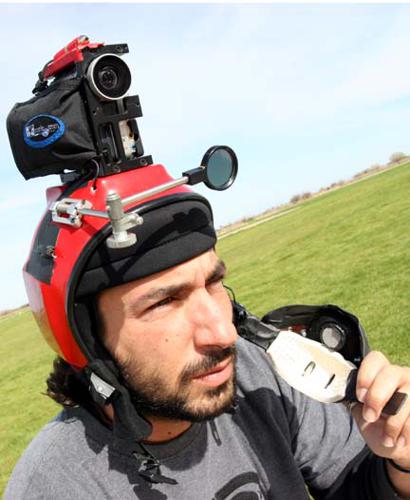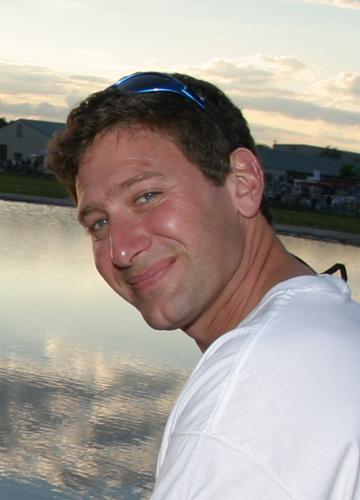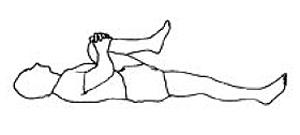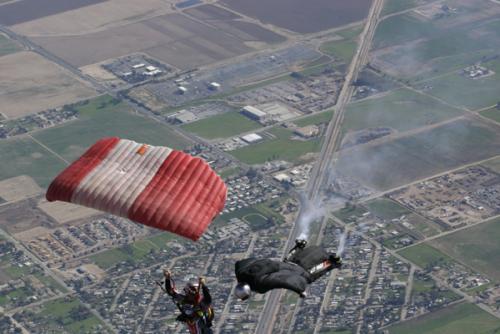Whether you are interested in freeflying as a main discipline, or you only want to make the occasional "fun jump", you will still want to follow the best and safest learning progression. Though freeflying can be a very fun discipline to take part in, it can also be very dangerous if you get it wrong. It is not something to rush into. You should take your time and enjoy the experience of flying in this new dimension. This article will introduce you to the steps you need to take to have a safe and fun experience and carry on doing so throughout your freeflying career.
Not Just Vertical
Freeflying isn’t just about learning to fly headup and headdown, it’s everything (yes belly flying too). As your skills improve you will realize that you can use all angles and positions between headup and headdown. Once you are proficient on your back, belly, feet and head, you will see that everything flows together and you end up moving in between these positions with ease.
To get to this stage you need to have a solid base in all these positions and an understanding of what the air is doing to your body. Too many people, especially now that freeflying is becoming so popular, go straight to headup flying after AFF and quickly move to headdown. The majority of these people are limiting themselves in the future and will find that they have to go back and learn basic belly flying and back flying to progress any further.
I will now go through the steps I believe necessary to become proficient at this discipline. Future articles in this series will go through some of these steps in more detail, explaining how to do them, how to practice them, and drill dives to improve these skills. You should try to learn these skills in the order listed to increase the learning curve.
Belly Flying
The most important thing is to become proficient on your belly. This doesn’t mean you need to become a 4-way master, but learning how to move around the sky with control certainly helps (especially now that hybrids are becoming more common).
You should learn the following:
Fall rate control
Horizontal movement (forwards, backwards and sidewards)
Center point turns
Diving to a formation
Docking on a formation
Superpositional moves (e.g. sidesliding while moving forwards – known as carving)
Break off procedures (flat tracking)
It also helps if you experiment with barrel rolls, forward loops and back loops to get used to not just being on your belly. All these skills will become very beneficial in the future. The other advantage to learning to fly on your belly is that you will be getting used to flying close to other people and will be learning the necessary skills to do this, even though it is in a different position.
Tracking
By now, you should have already learned how to flat track. It’s time to take tracking one step further. Find a coach or someone who has experience leading tracking dives and learn the following:
Tracking on exit
Heading control
Fall rate control
Speed control (speeding up/slowing down)
Moving Sideways
Break off procedures (different on tracking dives)
Tracking is a big part of freeflying. Learning these skills will help on breakoff, especially with larger groups, and will also help you when it comes to tracking dives.
Back Flying
Back flying is the first big step towards learning headup flight. You won’t be able to see the ground and you will start to get used to feeling the air on your back and the other side of your legs. This skill can be used a lot in freeflying when you get low on a jump or become unstable. This position is used to get back where you want to be, while preventing corking (suddenly lose speed) and hurting someone.
You should learn:
Heading control
Fall rate control
Horizontal movement (forwards, backwards and sidewards)
Turns
Barrel rolls from belly flying to back flying and back again
Front/Back loops from belly flying to back flying and back again
The advantage of back flying is that its speed range is huge. You can stay with a belly formation quite easily, but you can also speed up so that headdown flyers can stay with you without a problem. This diversity is what makes it such a useful technique in freeflying.
Headup Flying
This is where things start to get a bit different. Because you are in a vertical orientation, you have to learn how to move your body differently, move your arms and legs differently, whilst remembering that arching doesn’t make you stable at all. In later articles we will cover all of this in a lot of detail, explaining how and why, but you must always remember that an article is in no way a substitute for a coach. Whenever you have the chance, get coaching!
Things you need to learn:
Heading control
Fall rate control
Horizontal movement (forwards, backwards and sidewards)
Turns
Transitions (cartwheels, front loops, back loops)
Independent arm movement (altimeter checks, taking docks, etc)
Correct exit technique
Breakoff procedures (you can’t simply go to your belly and track)
Headup flying is much faster than any of the other positions. Because of this, every movement has a much larger effect than it would if you were going slower. The air is moving over you much faster and therefore has much more power behind it. Therefore, you have to be very careful with your movements to ensure the safety of yourself and others.
Back Tracking
Back tracking is a very important skill in freeflying, especially when starting to learn headdown. During breakoffs it adds a whole new perspective and gives you more awareness. Once you have learned headdown this position will open up more angles and add fluidity to your jumps. Backtracking is what I call a power position, this means that when your learning it you have to put in a lot of energy to keep an efficient position and to speed up, etc..
Things you should learn:
Back tracking exit
Heading control
Fall rate control
Speed control (forwards/backwards)
Moving Sideways
Break off procedures (different on tracking dives)
Transitions (back to belly/belly to back)
Once you have learned these skills, try going on a tracking dive, getting next to the base and transitioning to your back track position, while staying relative. Talk to an experienced freefly coach and ask about leading a tracking dive; you’ll learn a lot.
Headdown
Learning headdown brings a whole new level to your freeflying. Everything flows together much better and you can move around the sky with more ease. While moving around becomes so much easier, collisions become much more of a danger and you must be even more cautious. This position is not a power position. By this I mean that once you are used to keeping your legs wide you will be able to move around smoothly and fast without having to push into your movement.
Again you should aim to learn the basics before you start work on complex manoeuvres. Use this list:
Correct exit technique for jumping with others
Heading control
Fall rate control
Turns
Horizontal movement (forwards, backwards and sidewards)
Transitions (front loop, back loop and cartwheel) both to/from headup and from headdown to headdown
Independent arm movement (altimeter checks, presenting for docks, etc)
Correct breakoff procedures
Once you’ve done this you can start to work on using your skills to take docks, carve, etc.
Jumping with Others
When you start to jump with other freeflyers, you have a lot more to think about, including where the other jumpers in your group are at all times. As a minimum you should specify the following for a freefly jump with others:
Exit
Content of jump (don’t just say ‘we’ll see what happens’, have a plan and stick to it)
Base (specify someone as a person, everyone should then work towards them for a level)
Breakoff (what is the breakoff height, make sure everyone knows where the others are and do not go straight to their belly and track, slowly decrease your speed as you track away)
When you are just learning freeflying you should only be jumping solo or with an experienced freeflyer. Use the following as a rough guide to how many people, maximum, you should be jumping with:
0-100 freefly jumps: Solo’s or 2 Ways
100-300 freefly jumps: Up to 3 ways maximum
300-500 freefly jumps: Up to 5 people maximum
After this I try to use good judgement and common sense
If you have only ever done 2-ways then at the most you should only allow yourself to go on 3-ways.
Safety
Freeflying can involve a huge range of speeds, trajectories and positions, which presents us with many possibly dangerous situations. Because of this you need to ensure you have the correct training and also the right equipment.
Your container should fit well. You should not use a leg throwaway system, only BOC throw out or pull out is acceptable. The leg straps should fit right and not easily slip down your legs. You should also have some kind of bungee between the two leg straps to make sure they do not move around in freefall. It should have good riser and bridle protection with an absolute maximum of 1” exposed bridle near the BOC. Your pins and flaps should be tight. A good test is to gently lift your rig by each pin cover separately - if the covers stays closed then you’re good to go, but if the cover opens when lifting then get the opinion of an experienced rigger.
You should have a minimum of 2 altimeters: one visual and one audible. This is important as when you are learning to freefly it can be difficult to see your visual altimeter and it is easy to forget that you will be falling much faster than you would be if belly flying. The audible altimeter will remind you of this.
Wear a hard helmet. Don’t think you can get away without a helmet or just a frapp hat. Hard helmets might not save you from everything, but can mean the difference between life and death. If you’re just starting freeflying, don’t even think about wearing a camera helmet. This just adds to the list of new things you will have to think about and will take your awareness away from other more important matters. Some people get away with a full face helmet but if you are learning to freefly then I would suggest an open face. This allows you to keep better eye contact with your coach or other jumpers.
Any clothing you wear should be durable and secure. It shouldn’t be able to cover any of your handles and shouldn’t be excessively baggy. A good all round freefly suit will do the job. When learning headup, a lot of people like to wear trousers and a baggier top to help them. If you’re doing this, then make sure the top is tucked in well and is secure.
You should always use an AAD of some form when freeflying. You can easily have collisions when freeflying and closing speeds can be upwards of 100mph. It is also very easy to lose altitude awareness. An AAD could save your life, fatal collisions have happened to very experienced freeflyers, why couldn’t it happen to you?
The next article in this series will concentrate on how to do the things mentioned in this progression list. There will be ground exercises and tips on performing these in the sky.
Louis Harwood is a freeflyer from the UK and jumps at Target
Skysports, in Hibaldstow. He has competed for the last two years in the Artistic nationals, he has two silver and one gold medal in B catagory freefly, freestyle and skysurf. www.avalore.co.uk






